There are 12 snakes in Rhode Island that are endemic to the state including Ratsnakes, Garter snakes, Water snakes and more. Below is an overview of eash of those.
Interestingly enough, there are no venomous snakes found in Rhode Island. Timber rattlesnakes (Crotalus horridus), which are venomous, were spotted on the land fifty years ago, but not again since.
There are twelve snakes native to Rhode Island and these are their names as well as a little bit of information about them.
Table of Contents
Snakes in Rhode Island
1. Allegheny Ratsnake

- Experience Level: Beginner
- Family: Colubridae
- Scientific Name: Pantherophis alleghaniensis
- Other Names: Eastern rat snake
- Adult Size: 42 to 72 inches
- Lifespan: 20 years +
- Average Price Range: $50 t0 $600 per snake
Rat Snakes are amongst one of the most popular snakes besides the corn snake. They are hardy and docile, which makes them great for beginners.
Also known as the Eastern Ratsnake, they have shiny, black scales and a white underside with an almost checker-like pattern. Their chin and throat may also be a cream or off-white color, depending on the snake.
They can be found in hardwood forests, thickets, forested wetlands, fields near forests, farmlands, and sometimes in backyards with birdhouses or rats. They like to eat rodents, birds, and their eggs.
2. Northern Watersnake
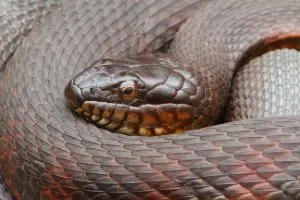
- Experience Level: Beginner
- Family: Colubridae
- Scientific Name: Nerodia sipedon sipedon
- Other Names: Watersnake
- Adult Size: 24 to 55 inches
- Lifespan: 9 years
- Average Price Range: $20 to $80 per snake
- Where to buy: backwaterreptiles.com
Northern Watersnakes are popular pets since they do not require much effort and are relatively safe, even around children.
They are usually dark in color, ranging from brown, tan, to grey. They also have square blotches on their backs and sides that may alternate or become bands throughout their length.
Watersnakes obviously live in aquatic habitats, which is why they are called water snakes. They like to bask on rocks by still or slow-moving water such as seasonal pools, lakes, and ponds.
They like to eat fish and amphibians, swallowing them whole and alive. They eat all kinds of fish species such as smallmouth bass, minnows, bullhead catfish, hogsuckers, sunfish, and brook trout.
One interesting thing is that they look very similar to copperheads. Check out the following article for more on the difference between Copperheads and Northern water snakes.
3. Eastern Garter Snake

- Experience Level: Beginner
- Family: Colubridae
- Scientific Name: Thamnophis sirtalis sirtalis
- Other Names: Garter Snake
- Adult Size: 18 to 26 inches long
- Lifespan: 10 years
- Average Price Range: $20 to $300 per snake (depending on size)
- Where to buy: backwaterreptiles.com, undergroundreptiles.com
Eastern Garter Snakes are relatively small and remain active during the day. They like to soak often, especially around their shedding period so they should always have a soaking bowl readily available in their tank.
Garter snakes are docile and will not grow to be too large, making them a very beginner-friendly reptile. If threatened, they will release a musk in order to ward off predators.
Common Garter Snakes can range from dark olive-green to brown or black with a distinctive yellow or off-white stripe running throughout the length of their body.
In the wild, they can be found in many places like marshes, woodlands, meadows, or hillsides.
These snakes feed on leeches, slugs, worms, small fish, amphibians, and even other snakes. They are also immune to toxic frogs that secrete toxins from their skin in order to drive away prey.
4. Northern Brown Snake

- Experience Level: Beginner
- Family: Colubridae
- Scientific Name: Storeria dekayi dekayi
- Other Names: DeKay’s Snake, Brown Snake
- Adult Size: 9 to 15 inches
- Lifespan: 7 years
- Average Price Range: Around $20 to $30 per snake
- Where to buy: backwaterreptiles.com, reptilesncritters.com
Because the Northern Brown Snake is popular prey amongst many predators, they are, understandably, always on guard. These easily stressed-out snakes will release a musk when they feel threatened.
Because of their demeanor, it will take gentle and only short periods of handling. You won’t have to worry about them biting since they are shy, docile snakes.
These keel-scaled snakes can range from a light tan to a darker brown in coloration. They may have patterns along their bodies that are small and may either be darker or lighter compared to the rest of them. Their chins and underside may be off-white or pale yellow and their tongues are black.
Brown snakes are the best choice for enthusiasts that want to create a naturalistic aquarium because they love live plants. Being in a natural, alive terrarium will cause them to exhibit more natural behaviors, which can also make them feel right at home.
In the wild, they come from grasslands, forests, wetlands and it is not uncommon to encounter one in residential areas.
5. Eastern Hognose Snake
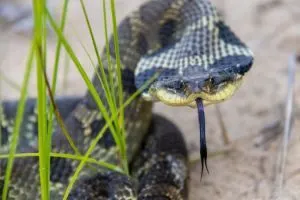
- Experience Level: Beginner
- Family: Colubridae
- Scientific Name: Heterodon platirhinos
- Other Names: Eastern hog-nosed snake
- Adult Size: 20 to 33 inches
- Lifespan: 12 years
- Average Price Range: $100 to $500 per snake
- Where to buy: xyzreptiles.com, snakesunset.com, backwaterreptiles.com
The Hognose snake is known to be one of the best pet snakes for enthusiasts since they are not fussy and are comfortable with human interaction. They also stay relatively small.
These worm-like snakes have a large, round head with an upward-facing snout, which is what we all love about them. They are a dark grey or olive-green, but some are also yellow, tan or light brown with dark brown spotted patterns on their head and sometimes their bodies.
They prefer to inhabit sandy woodlands, farmland, coastal areas, and fields where they feed on frogs, salamanders, invertebrates, birds, and small mammals. They can use their hog-like nose to get into their prey’s burrows more easily.
6. Eastern Milk Snake
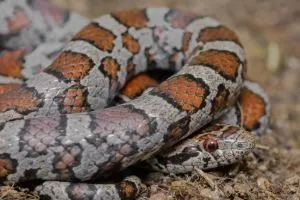
- Experience Level: Beginner
- Family: Colubridae
- Scientific Name: Lampropeltis triangulum triangulum
- Other Names: Milk Snake
- Adult Size: About 4 feet
- Lifespan: 22 years
- Average Price Range: $50 to $300 per snake
- Where to buy: backwaterreptiles.com
Eastern Milk Snakes are a subspecies of the milk snake and are also classified as a kingsnake.
Kingsnakes are non-venomous, friendly, docile, and beautiful to look at. One very popular pet is the Mexican black kingsnake because of it’s docile nature.
Eastern Milksnakes are tan or brown with black-brown bands and blotches that loop around the length of their body. Their skin can sometimes be a pale yellow with almost a red striped pattern, similar to the Western Milk Snake and the venomous Coral snake, depending on the Milk Snake.
They can be found in meadows, pastures, under any artificial cover, by the edges of watercourses, by mountain cliffs, and woodlands. These carnivorous snakes feed on lizards, reptile eggs, birds and their eggs, mice, and sometimes insects.
7. Eastern Ribbon Snake
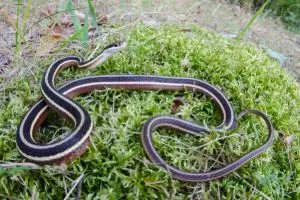
- Experience Level: Intermediate
- Family: Colubridae
- Scientific Name: Thamnophis sauritus sauritus
- Other Names: Common Ribbon Snake
- Adult Size: 16 to 28 inches
- Lifespan: 12 to 20 years
- Average Price Range: $15 to $25 per snake
- Where to buy: backwaterreptiles.com
Ribbon snakes are very active, inquisitive snakes but can be quite timid and nervous. This is why they are known to be best kept as display snakes, as they do not like being handled.
This is why they are not recommended as beginner snakes.
They are slender and have three pale yellow stripes along the length of their dark bodies. They also have a brown lateral stripe on their bellies.
They are a part of the Garter snake family, but will not feed on the same things. Ribbon snakes are carnivorous and feed on toads, frogs, tadpoles, earthworms, newts, and spiders.
Since they are semi-aquatic, you can find them close to the water in places such as wetlands, and river or lake shorelines near forests.
8. Smooth Green Snake

- Experience Level: Intermediate
- Family: Colubridae
- Scientific Name: Opheodrys vernalis
- Other Names: Green Snake
- Adult Size: 14 to 20 inches
- Lifespan: 6 years
- Average Price Range: $8 to $10 per snake
- Where to buy: undergroundreptiles.com
Smooth Green snakes are carnivorous but prefer to feed on insects, making them somewhat insectivorous. This is the perfect reptile for owners that might be squeamish about feeding dead mice to their snakes.
Smooth Green Snakes feed on insects like spiders, moths, ants, snails, slugs, worms, and spineless caterpillars.
One drawback that does not make them great pets, though, is that they are way too timid for human interaction. However, they are known to be harmless and some might even enjoy being handled.
All in all, they are not the easiest snakes to keep captive since they are very anxious and easily stressed-out.
They can be found in open woods, stream edges, marshes, and meadows. They thrive in moist, grassy areas.
Just like their name suggests, these snakes have bright green scales, which can range in shade. They stay relatively small and may have a pale yellow underside with little, beady, black eyes.
9. Eastern Worm Snake
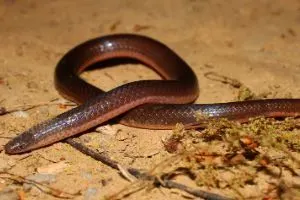
- Experience Level: Intermediate
- Family: Colubridae
- Scientific Name: Carphophis amoenus amoenus
- Other Names: Wormsnake
- Adult Size: 7 to 11 inches
- Lifespan: 4 years
- Average Price Range: $14 to $25 per snake
- Where to buy: reptilesncritters.com, backwaterreptiles.com
In general, worm snakes are not ideal pets because of their timidness. They like to remain hidden in their substrate, which can make it hard to keep track of their health.
These shy reptiles dislike being handled and will wiggle around in your hand. You may also feel them press against you with a bit of a strong force.
Eastern Worm Snakes are shiny, scaley, and brown with a pointy tail. The color of their body can range from a light to darker brown and may have pink or white undersides.
You can find these snakes in habitats that are damp or near woodlands such as hilly woodlands or farmlands nearby. They prefer grassy or wooded hillsides near streams of water.
During dry periods, they will burrow down underground where the soil is moist in order to get the dampness they need to survive.
These worm snakes eat exclusively earthworms, swallowing them completely alive. This makes it easy for them to fall prey to other animals that eat earthworms.
Although it is rare, they might also sometimes eat insect larvae or slugs.
10. Northern Black Racer
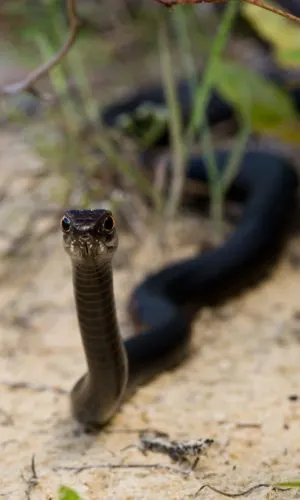
- Experience Level: Intermediate (Captivity not recommended)
- Family: Colubridae
- Scientific Name: Coluber constrictor constrictor
- Other Names: Black Racer
- Adult Size: 33 to 65 inches
- Lifespan: 10 years
- Average Price Range: about $40 per snake
- Where to buy: backwaterreptiles.com
Although Northern Black Racers are non-venomous, they are sometimes a little bit aggressive when defensive. As long as you don’t startle or corner it, it will not deliberately try to attack you.
Black racers do not usually feel threatened by humans but you should still not give it a reason to use self-defense. A bite can still be painful and susceptible to infection regardless of whether or not there is venom.
When threatened, they will raise their head.
As far as these snakes go as pets, they are not particularly docile and will only rarely become accustomed to being handled. Black racers also like to travel a lot over long distances, making them unsuitable for a tank or terrarium habitat.
Northern Black Racers have large, long, slender, solid black, round bodies with a white chin and a faded blue underside. They have smooth, matte-looking scales and a head that is almost the same width as their body.
Some black racers may be blue-gray, brown, dark grey, or rust-colored with blotches on their back as well.
You can find these snakes in habitats that are brushy such as grasslands, old fields, rock ledges, ridges, and agricultural fields.
They prey on toads, frogs, small birds, rodents, and smaller snakes. They may also sometimes feed on insects and invertebrates like moth larvae or butterflies.
11. Northern Ringneck Snake
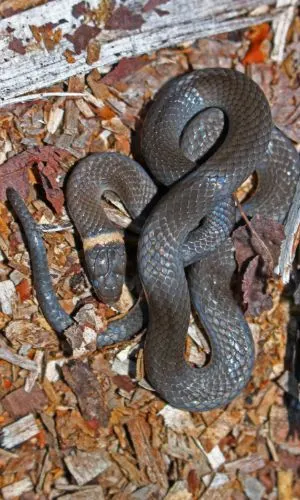
- Experience Level: Intermediate (Captivity not recommended)
- Family: Colubridae
- Scientific Name: Diadophis punctatus edwardsii
- Other Names: Collared snake, fodder snake, Kingsnake, ring snake, ringed snake
- Adult Size: 10 to 15 inches
- Lifespan: 20 years
- Average Price Range: $20 to $30 per snake
- Where to buy: backwaterreptiles.com
Northern Ringnecks are also not recommended for captivity even though they post no threat and physically cannot harm anyone from a bite due to their teeth being tiny and rear-facing. They cannot open their mouths wide enough to bite anyways, but they also do not tend to bite when threatened.
Actually, these snakes are technically slightly venomous but since they aren’t aggressive and don’t wish to bite in the first place, they pose very little threat to anyone who handles them. They have no potential to kill a human or even any other household pet.
Although, if you do get bit by one, you should still take action since it can be susceptible to infection, as any snake bite would be.
This small snake is very difficult to breed in captivity, meaning that all breeders or owners must have caught them from the wild. Captivity should be avoided due to the fact that they are threatened in their native habitats.
They are nocturnal snakes and will rarely be seen in the daylight.
These tiny snakes are slender, grayish, with an orange and yellow band around their neck, which is how they got their name. They may also have a yellow or orange underside.
They can be found in most habitats, but generally prefer to live in wooded areas. They feed on insects, salamanders, newts, earthworms, slugs, small toads or frogs, and baby snakes.
12. Northern Red-bellied Snake
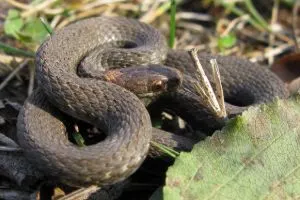
- Experience Level: Expert (Not recommended as pets)
- Family: Colubridae
- Scientific Name: Storeria occipitomaculata occipitomaculata
- Other Names: Copper snake, Red-bellied snake, Red-bellied water snake
- Adult Size: 8 to 11 inches
- Lifespan: 4 years
- Average Price Range: $30 to $40 per snake
- Where to buy: backwaterreptiles.com
Red-bellied Snakes stay small and are docile, but do not make very good pets. This is because even if you make your best efforts to keep them happy in captivity, they often end up starving or stressing to death.
These small snakes get their name from their chestnut, brown, or slate-grey bodies with their distinctive red or orange underside. You may find three light spots behind their head as well.
They enjoy moist habitats like woodlands, moist meadows, swampy forests, marsh, the borders of bogs, and open fields. In these environments, they enjoy mainly earthworms and slugs but also feed on insects, snails, pillbugs, small salamanders, and beetle larvae.
Interestingly enough, they can actually extract snails from their shells due to special adaptations of their jaws and teeth.
Conclusion
All in all, Rhode Islanders have a bunch of cool snakes to check out. These are the twelve that are native to your area and ones you should definitely know about if you are a lover of snakes.
If you are considering wanting to keep any of these as a pet, you should check out the exotic pet laws in your area and make sure you have your licenses up to date if you are thinking about breeding or selling.
Leave a comment below about which snake you like most from this list!
Snakes in other states
Reference:
